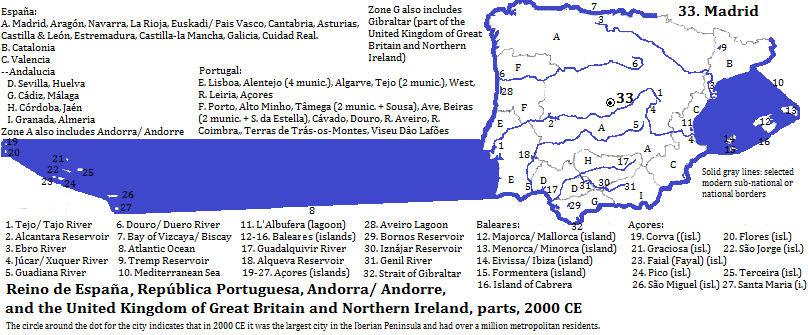Madrid
Madrid, the capital of España (Spain) is located southeast of the Guadarrama Mountains, on a feeder to the Tajo (Tejo or Tagus) River in the Province and Community of Madrid. The Prado Museum, dating from the 18th century, is among its attractions. Nearly 6.4 million live in the metropolis,1 over 3.1 million in the city proper.2 The two tallest buildings are the Torre (tower) de Cristal, with its 10 meter high entrance hall, and the Torre Caja Madrid (both 820 feet, 2008), with its 13.85 meter high entrance hall. Other notable buildings include the Torre Picasso (513 feet, 1988), which is lit up at night, and the tallest building in the city from 1988 to 2007; the Torre de Madrid (466 feet, 1957), the tallest building in the city from 1957 to 1988; the Edificio (building) España (384 feet, 1953), the tallest building in the city from 1953 to 1957; the Torre Colón (381 feet, 1976), nicknamed the Enchufe (plug-in) because of the shape of its top; the Puerto (port) de Europa I and II (both 374 feet, 1989), which slant; the Telefonica Building (338 feet, 1929), the tallest building in the city from 1929 to 1953; the Ampliación del Museo del Prado (2007), an extension of the famous museum; the Iglesia (church) de San Jeronimo el Real (1505); and the Teatro (theatre) Real (1850).3
The Adolfo Suárez Madrid-Barajs airport is the nation's busiest.4 Its Terminal T4 is said to be one of the world's largest airport terminals.5
Alcalá de Henares, a city of nearly 201 thousand6 located within the metropolitan area, was the world's first city planned as a college town. The old university is now a UNESCO World Heritage Site.
External references
Interior of the old university, Alcalá de Henares, Province and Community of Madrid, España (Spain)
Historical maps

Footnotes
1. Eurostat Larger urban zone (2014) column of https://en.wikipedia.org/wiki/List_of_metropolitan_areas_in_Europe, accessed December 28, 2015. It is currently the largest city in the Iberian Peninsula.
2. 2015 figure from the side bar of https://en.wikipedia.org/wiki/Madrid, accessed April 18, 2016.
3. Information about buildings is from emporis.com, accessed April 18, 2016.
4. List_of_busiest_airports_in_Spain, 2014 table, accessed December 30, 2015.
5. https://en.wikipedia.org/wiki/Madrid, accessed April 18, 2016.
6. 2014 figure from the side bar of https://en.wikipedia.org/wiki/Alcal%C3%A1_de_Henares, accessed December 28-30, 2015.

